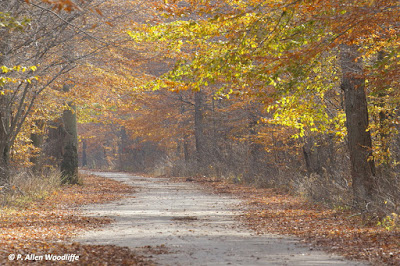There is a certain appeal to get out in a forest or other natural setting, and not necessarily with birds or butterflies as a primary focus. The joy is just to get out and soak up as much of the natural atmosphere as possible, enjoying the light, the shadows, the muted colours and perhaps most important to my way of thinking, the solitude. Any form of wildlife encountered is a bonus. The latter part of November and early part of December are two of my favourite times for this experience, and the setting at Rondeau is perfect. One can spend several hours on the trails and closed roads, and never see another person.
There is an activity I recently had pointed out to me, called 'forest bathing', where one spends time in a forest, or at least in the vicinity of trees, soaking up the fresh air and the atmosphere, to experience various health benefits including a reduced stress level. According to Wikipedia, forest bathing apparently originated in Japan in the 1980s.
To that I say 'Nonsense'.
I've been doing it since the early 1970s. My dad used to do it from time to time in his early years. While it may not have officially been named 'forest bathing', the reality is that people have been doing this for decades, likely centuries or more. I'm sure that the likes of John Muir in the mid to late 1800s and Ansel Adams in the early 1900s, among others, did a lot of 'forest bathing' when they were out exploring the natural world in their time.
It is usually during these times when I seldom take my camera with a telephoto lens, knowing that a wide angle lens will be more useful to capture what I see.
One can sit in one spot for a time, or one can hike the trails and get the benefits of some cardio exercise, or even away from the trails (but if it is above freezing, be aware of ticks!!). And there is always something to see, especially on warmer, sunny days. I had this Eastern Comma flitting about on a warm sunny day on Nov 29, which according to ebutterfly, was the latest Ontario date for a butterfly added to that database in 2017.
Reptiles may be out, soaking up a last bit of sunshine before going underground for the upcoming winter.
 |
| Eastern Gartersnake |
The leaves have fallen by late November, as have a multitude of seeds. The trails and roadsides are covered, or at least lined along the edges, with a mix of leaves and seeds.
This first photo shows a packed roadside of beech nuts from the American Beech tree, with a few Tuliptree seeds mixed in. It had indeed been a great year for beech nut production, as well as acorns from oaks. While this 'mast' production will go along way towards placating the hunger of deer, Wild Turkeys, Blue Jays, Red-bellied Woodpeckers and mice, one cannot help but wonder if it also means a profusion of ticks that benefit when mice are more prolific. More mice, means more ticks, and the greater the chance of hikers encountering Lyme Disease in the following year.
This next photo, taken along a section of trail where Tuliptrees are a little more dominant, is made up entirely of Tuliptree seeds. Although Tuliptrees are prolific producers of seeds, only about 1% or so of the seeds are really viable and will germinate. The vast majority of these seeds will be enjoyed by squirrels, mice, etc.
The bright orange-red berries of Climbing Bittersweet are more visible against the muted colours of the forest late in the season.
The lake can be really riled up during sustained windy periods, or it can be quite calm and subdued. The riled up weather that occurred a short time before this photo was taken resulted in significant changes to the dynamic shoreline, such as this new pond area. Will it remain as a breeding pool for the rare Fowler's Toad this coming summer or be a feeding stop for shorebirds? Or will another storm make changes to this, making it only a very temporary feature?
Patterns in the sand are visible, the result of fairly strong winds in previous days.
While it is always nice to see birds and butterflies, etc., they are just a few of the multitude of reasons to get out and enjoy the natural world around us!














New Year greetings, hope you are rid of the dreaded lurgy soon.
ReplyDeleteLoved the post. A lovely term 'forest bathing' not heard that before, but we also indulge in making time to fast walk, stroll, wander, linger, several times a week. Beneficial? Definitely!
Love and blessings, Paula.
Hi Paula...thanks for the comment, and Happy New Year to you and Ian. I imagine you have so many beautiful areas in your part of the world to explore and enjoy!
DeleteI agree, a beautiful time of year to get out in the woods. Sorry about your cold.
ReplyDeleteThanks Furry Gnome....I think the worst of it is over, so I will be getting out again real soon, even in the snowy conditions.
Delete